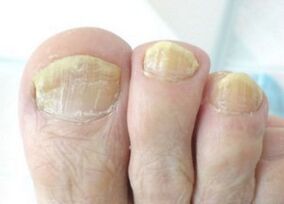Not everyone knows what onychomycosis looks like.In this regard, not every patient understands when to see a doctor.If you notice signs of onychomycosis, you must also determine at which stage the disease is and contact a specialist immediately.
disease symptoms
The first symptoms of fungus on the feet or hands are usually less obvious.Most often, this is a small injury to the nail.The side edges of the board as well as the free edges begin to turn yellowish.The presence of the disease can also be identified due to the lack of transparency at the base of the nail.
Sometimes you will see a gap between the record and the bed itself.Its formation is caused by the accumulation of fungal pathogens as well as many other microorganisms.These types of lesions are called distal lateral fungal forms.

Additionally, fungus on the hands or feet goes hand in hand with hyperkeratosis located under the nails.The name alludes to the phenomenon in which the nails begin to react to the presence of the fungus, keratinizing the nail bed itself.The deeper the fungus penetrates into the plate, the thicker the fingernail or toenail will become.
The final stage of this form is the failure of the entire nail.In addition, the matrix begins to participate in this process - this is where the nail begins to grow.Lamellar dystrophy occurs.
In addition, symptoms of the fungus intensify.Nail damage starts as small white spots.Over time, the types of these attractions have become more diverse and extensive.In addition, such symptoms can also be recognized by loose and rough nail plates.It is easily exposed when scratched.However, this form did not appear on the hands.It is associated with the first toe.
Symptoms of the next form of infection - proximal subungual - are lesions of the pad, which become red.After this, the tissue around the fingernails and toenails begins to swell and become shiny, and then changes in shape.The result will be separation of the cuticle from the plate.
Anyone is afraid of discovering fungus on themselves because it is dangerous because the next stage is the degenerative changes of the nail plate.The first symptom of this form is unevenness.They're easy to spot; they resemble uneven grooves across the entire nail.If this disease is completely ignored, the nails on your hands or feet may fall off completely.
The most dangerous fungi are those that are completely dystrophic.This is the most advanced form of the disease.Nails (if retained) are gray and thickened.The main symptom is complete or partial destruction of the board.
We are fighting the scourge

Before you start treating fungus on your hands and feet, you need to minimize negative outside influences.It is recommended to find out the cause of fungus on hands and feet and eliminate it.There are four most common reasons:
- Regular exposure to warm, moist environments.The important thing is that shoes must be dried, especially during the change of seasons, when shoes often get wet.Tights and socks should be chosen only from natural materials that do not cause heat and air exchange problems.
- Fungus on the hands and feet is often caused by low immunity.Walking barefoot on the floor is enough for the infection to stick to you.
- Frequent nail extension is also one of the most common causes of onychomycosis.It is recommended to repeat this process no more than once every six months.
- Any analysis will show that the most infectious fungi are viable spores.They can penetrate into the depressions between fingers and toes, remain dormant, and then begin to grow dramatically.This fungus can be found everywhere in public places.
Even if you notice the first symptoms of the fungus mentioned above, you should not start self-medicating.You need to go to an expert for analysis.The most common is to perform a scratch test to check your fingernails and toenails for the presence of fungus.The analysis is performed in an alkaline environment, examining the presence of mycelium under a microscope.
Treatment can only be started after the test shows a positive result.In fact, the first signs of fungus on your hands and feet may not be fungus at all, and may have an entirely different cause.For example, problems with internal organs can also be reflected on the nail plate.More extensive analysis is then required, most commonly biochemical blood testing.

In order to determine the fungal cause, doctors recommend analyzing the microbial cause.The analysis was carried out over a period of three weeks, during which the corresponding crops were grown.Although there are now modern technologies that can analyze the DNA of fungi to determine the cause of their formation.
common species
Of all hand and foot fungi, three types are most popular.The first is epidermophytosis.We are talking about a fungal disease that affects not only the fingernails and toenails, but also the skin around them.Most often, you can find this fungus in the bathroom or gym.
How does onychomycosis spread, you ask?Everything was bland.These are general hygiene products, linens, oilcloths, mats and other sports equipment, and even thermometers.Most commonly, this fungus occurs on the legs of men.It occurs less frequently on the hands due to less sweating.
Trichophyton of the feet is also common.This is because the disease is highly contagious.It is also spread through objects used by sick people, including sports equipment.It is extremely rare for children to become infected with this type of fungus.
Most often, young men are at risk, but the proportion is higher in the adult population.This disease often occurs in miners or workers in high-temperature workshops.In Europe, the disease is commonly known as "athlete's foot."This fungus does not appear on the hands.
The third most common variant is candidiasis.This phenomenon is also seen on the feet; it usually does not reach the hands.Most of these fungi are conditionally pathogenic, so they are present in everyone's body but do not cause disease.However, as immunity decreases, their pathogenicity can be observed.Additionally, they can enter the body through unwashed hands after sharing objects and through fermented dairy products.
Generally speaking, these are the main types of fungi you should be wary of in public places.Most of the time, protecting yourself from disease is pretty simple.Use only your personal belongings.Remember to wear flip flops in the shower or pool, and always see a specialist if you suspect fungus.Do not attempt to self-treat or self-diagnose.Even experienced doctors need lab tests to be completely sure.


















